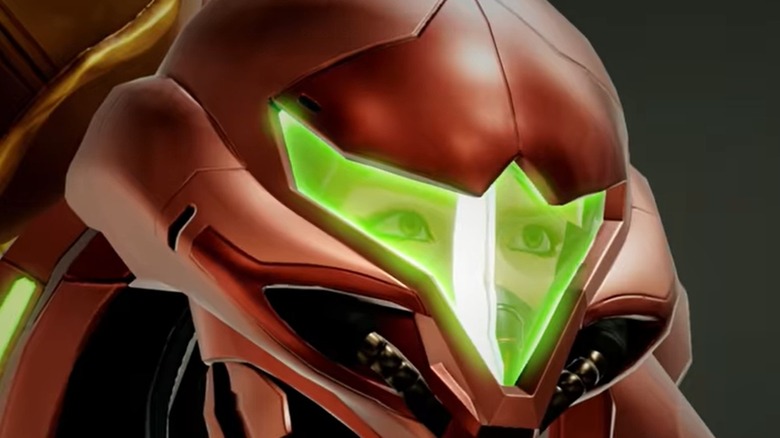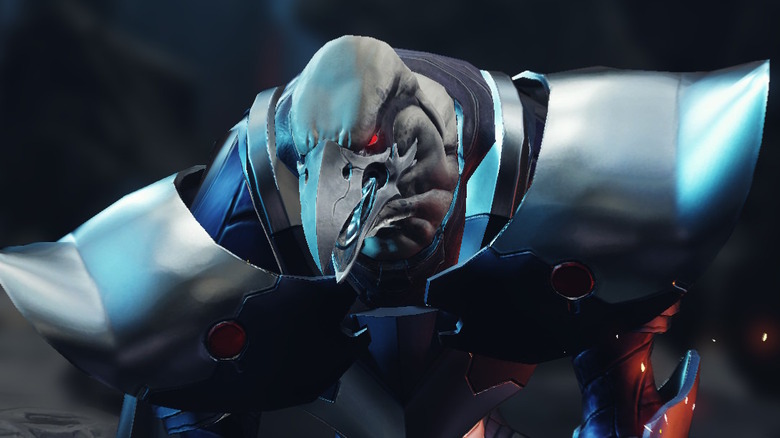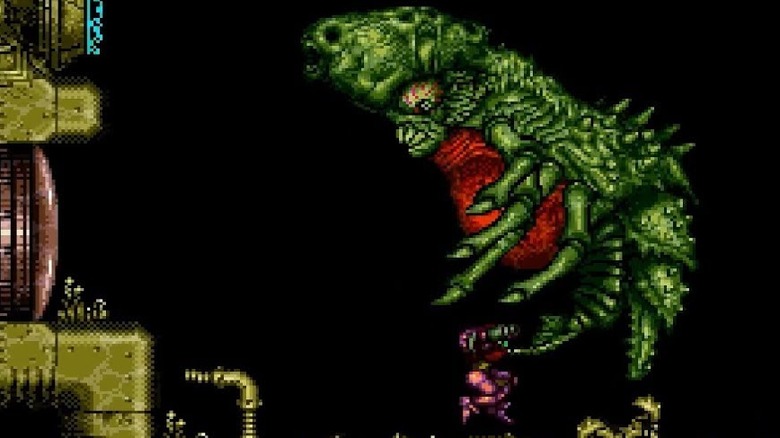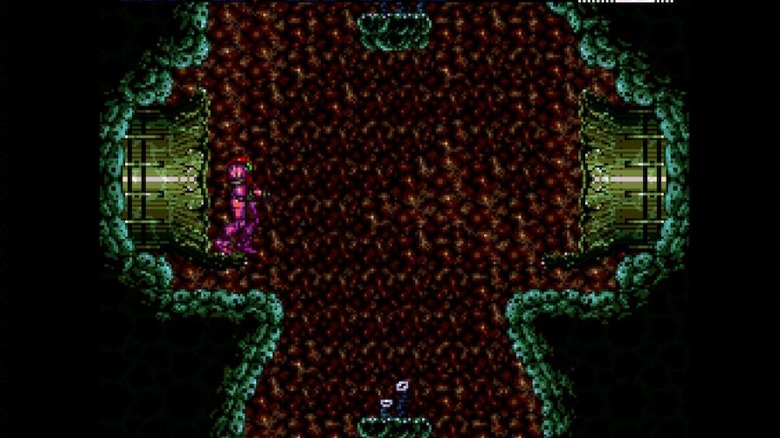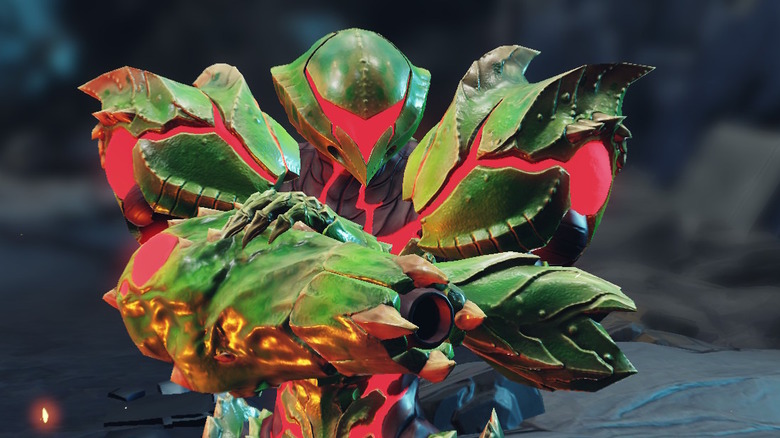Metroid Dread Easter Eggs Only True Fans Noticed
Despite its fondness for hiding secrets from its players, the "Metroid" series is not often one for deep cut Easter eggs or obscure references. Most of the homages and callbacks to older 2D "Metroid" games in the latest release for Switch, "Metroid Dread," are evident in the ways it sticks to — and evolves — the classic series formula established back in 1986. However, this is the end of Samus' arc that began in the original "Metroid," so it is bound to have some references to the older 2D "Metroid" titles.
Still, "Metroid Dread" is the first mainline "Metroid" sequel Nintendo has released since 2010's controversial "Metroid: Other M" for the Wii, and the new game definitely has its fair share of moments and designs that hearken back to previous games in the franchise. The story in "Dread" relies heavily on knowledge from old games and supplemental material about Samus Aran that only hardcore "Metroid" fans might have read.
Even though it just came out, fans are already discovering the tiniest details in "Metroid Dread" that tie into key moments and concepts from the series' lengthy history.
Beware of major spoilers ahead for "Metroid Dread."
Metroid Dread was first hinted at in Metroid Prime 3
The very first mention of "Metroid Dread" came in hushed whispers via gaming journalists in the mid 2000s. At the time, it was rumored to be a direct sequel to "Metroid Fusion" in development for the DS. According to an IGN report in 2005, the game was nearing completion — and then the project quietly faded until 2021. Mostly, that is. As a matter of fact, "Metroid Dread" has been around a lot longer than fans probably realize.
In 2007's "Metroid Prime 3: Corruption," Retro Studios left another bread crumb for fans regarding "Dread," seemingly hinting that the game's release was right around the corner.
Scanning the environment to learn plot and world information is a key part of the 3D entries in the franchise. A hard-to-find scan in Corruption reveals the text, "Experiment status report update. Metroid project 'Dread' is nearing the final stages of completion." This led fans at the time to believe "Dread" was still somewhere in development. It may have been, but that DS game is now long-abandoned, replaced by the new release that MercurySteam began developing after the success of "Samus Returns."
Raven Beak was actually first mentioned in Samus Returns
Speaking of "Metroid: Samus Returns," MercurySteam was clearly thinking about the wider series mythology when developing the remake of "Metroid 2: Return of Samus," as well as the idea of building a whole new "Metroid" game from the ground up. "Samus Returns" mechanics like Samus's Aeon abilities, the parry, and the addition of teleport stations in the levels all made their way over to "Dread." But it was here that the team at MercurySteam also foreshadowed the main villain who would fully arrive in "Dread."
The Chozo Memories in "Samus Returns" are rewards for finishing the game and achieving 100% completion in each area. These still images tell a version of the backstory of the Chozo and the creation of the Metroids. The memory received for just beating the game is the first time players got to see an image of Raven Beak, the ultimate enemy of "Metroid Dread."
If you acquire all the Chozo Memories in "Samus Returns," you unlock an 11th and final memory that hammers home Raven Beak's true nature. This memory explicitly depicts Raven Beak murdering the Thoha tribe of Chozo, an act that plays a major role in the story of "Dread" and is recapped and given context in the new game.
The Central Units may be related to Mother Brain
A big hook Nintendo leveraged when marketing "Metroid Dread" was the concept of the E.M.M.I. encounters. These robots that hunt Samus down will kill you in one deadly strike, which is nearly impossible to counter. "Dread" both evolves the concept of the SA-X in "Metroid Fusion" and cashes in on the trend of AI nemesis enemies that hunt down the player in games (popularized by the likes of Mr. X in "Resident Evil 2"). At the end of the E.M.M.I. sections, you must always fight a large, round, metallic-plated brain called a Central Unit. This will grant Samus access to the Omega Cannon, a temporary power-up that allows you to kill E.M.M.I. units.
The design of the Central Units, with their giant exposed brains and massive eyes in the center, might look more than a little familiar to fans of the games. They bear a strong resemblance to classic series boss Mother Brain, as well as the Aurora Units in "Metroid Prime 3."
On the official Nintendo America Twitter account, Nintendo did more than subtly suggest that these brain-like creatures are indeed references to Samus' nemesis Mother Brain. The company tweeted a clip of Samus with a Central Unit, along with a reference to the familiar design — and a conspicuous brain emoji.
Draygon's carcass
The backgrounds in "Metroid Dread" are full of small details and animations, like creatures big and small scurrying across the environment. In one of the earlier areas of the game, you can see a creature in a vat whose shape will stir a memory in fans of "Super Metroid." While all you get is the silhouette of this poor monster, fans on Reddit have noted that it looks a whole lot like Draygon, the flying boss of Maridia from "Super Metroid." This is at very least a nice little callback to a classic game in the series, however it could mean something more.
Fans on Reddit have pointed out that there appears to be some empty space on the map above the area where the Draygon tube is found, which could mean a future DLC could feature Draygon as a boss. While that seems like a bit of wishful thinking, cool easter eggs like this serve two purposes: They call back to the series' glory days and they make fans hopeful for the future of the "Metroid" franchise.
Power Bombing a tube recalls one of Super Metroid's coolest moments
In retrospect, "Super Metroid" gives you the Power Bomb — one of the most powerful and destructive tools in Samus's arsenal — super early on. In one of the most memorable and cleverly-designed moments from the SNES classic, the player has to Power Bomb a glass tube to make it shatter, allowing Samus to get to the next area. Later games, like "Dread," save the Power Bomb for almost the very end.
The "Metroid Dread" take on the weapon's impact is cinematic and powerful, making it truly worth the wait. In fact, the game's level design even references the iconic tube-shattering moment from "Super Metroid." In order to get to the final area of the game, the player must bomb a screen-length tube to destroy it. The way this scene is framed and presented in "Dread" is notably similar to the tube in Maridia from the 1994 classic.
Metroid Dread references the manga's Power Suit origin
Despite being a direct sequel to a nearly 20-year-old GBA game, the story in "Metroid Dread" is even more reliant on deep knowledge of "Metroid" lore than most fans will likely expect. Yes, to understand what is going on in "Dread," it is more or less required to play "Fusion." But beyond that, knowledge of Samus' origin is key to making sense of the information the game dumps on you.
Near the end of the game, the AI leading players through planet ZDR, ADAM, tells Samus that she has completed her transformation and is fully a Metroid now. He also explains that the Chozo DNA Samus received as a child on Zebes was a mixture of both Thoha and Mawkin tribe, which gave her great power. This is a direct reference to Samus's backstory as explained in the "Metroid" manga. Released in 2003, this series of comics explained the Bounty Hunters origin and the creation of her iconic Power Suit.
As a child, her home planet was invaded by the dragon-like Ridley and Space Pirates. After Samus was nearly killed, she was taken in by the Chozo, injected with Chozo genes and given the Power Suit to survive. The suit proved to be essential for her human body to withstand the environment on Zebes, but the combination of the suit and the genetic mods are also what give Samus all her special abilities.
The big twist makes more sense to fans that have read the manga
The big twist at the end of "Metroid Dread" gives Samus the Luke Skywalker treatment, as Raven Beak reveals that it was his DNA that was given to Samus back on Zebes in the manga. Raven Beak even calls himself her father. This final huge plot twist might land better for fans who have the context for it. For continuity sticklers, it is actually fairly impressive that MercurySteam managed to tie the end of Samus' arc (for now) to there obscure comics origin that, despite not being widely known, is part of the official series canon.
Knowing this, the twist ties all the elements of Chozo lore in "Dread" together to one conclusion. Raven Beak is the leader of the Mawkin and the most powerful, so Samus has the strongest genes. His end-goal is to extract Samus's DNA and clone it to make an army of powerful Metroid-Chozo hybrids. Of course, it seems he never expected that Samus' hybrid nature would make her impossible to control.
Samus's final suit visually signifies her true nature
In the final moments of the last boss encounter with Raven Beak, Samus undergoes a drastic physical change. Players already know the Metroid DNA has taken over her body, but in this moment, it fully bonds with her Power Suit and makes her truly the most powerful Metroid to ever live. The suit itself looks unlike anything fans have seen before, its rough edges differing greatly from the clean aesthetic of Samus' armor throughout the rest of the game.
These sharp points accentuating her shoulders mimics the talons of a Metroid, as well as the armored hides of its evolved forms. At the same time, the color scheme of the suit mimics the creature whose DNA Samus now shares. It is green all over with a red glow, instantly recalling the colors of a Metroid, and the red radiates from within — just like the pulsing nucleus of a Metroid.
Samus's final armor in "Metroid Dread" acts as a both a callback to the Metroids of the past while being true to how cool she is as a character.

